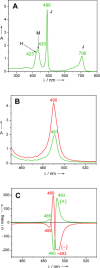Electron cryo-microscopy of TPPS4⋅2HCl tubes reveals a helical organisation explaining the origin of their chirality
- PMID: 23908093
- PMCID: PMC4281918
- DOI: 10.1002/cphc.201300606
Electron cryo-microscopy of TPPS4⋅2HCl tubes reveals a helical organisation explaining the origin of their chirality
Abstract
A widely studied achiral porphyrin, which is highly soluble in aqueous solutions (TPPS4), is shown to self-assemble into helical nanotubes. These were imaged by electron cryo-microscopy and a state-of-the-art image analysis allows building a map at ∼5 Å resolution, one of the highest obtained so far for molecular materials. The authors were able to trace the apparent symmetry breaking to existing nuclei in the "as received samples", while carefully purified samples show that both handnesses occur in equal amounts.
Keywords: J‐aggregates/H‐aggregates; chirality; electron cryo‐microscopy; helical reconstruction; porphyrinoids; self‐assembly.
© 2013 The Authors. Published by Wiley‐VCH Verlag GmbH & Co. KGaA. This is an open access article under the terms of the Creative Commons Attribution License, which permits use, distribution and reproduction in any medium, provided the original work is properly cited.
Figures




Similar articles
-
Structure of HIV-1 capsid assemblies by cryo-electron microscopy and iterative helical real-space reconstruction.J Vis Exp. 2011 Aug 9;(54):3041. doi: 10.3791/3041. J Vis Exp. 2011. PMID: 21860371 Free PMC article.
-
On the dynamics of the TPPS4 aggregation in aqueous solutions: successive formation of H and J aggregates.Spectrochim Acta A Mol Biomol Spectrosc. 2006 Jan;63(1):227-33. doi: 10.1016/j.saa.2005.05.009. Epub 2005 Jun 13. Spectrochim Acta A Mol Biomol Spectrosc. 2006. PMID: 15955725
-
pH dependent molecular self-assembly of octaphosphonate porphyrin of nanoscale dimensions: nanosphere and nanorod aggregates.Int J Mol Sci. 2011;12(3):1464-73. doi: 10.3390/ijms12031464. Epub 2011 Feb 24. Int J Mol Sci. 2011. Retraction in: Int J Mol Sci. 2021 Jan 29;22(3):1327. doi: 10.3390/ijms22031327. PMID: 21673901 Free PMC article. Retracted.
-
Cryo-EM of Helical Polymers.Chem Rev. 2022 Sep 14;122(17):14055-14065. doi: 10.1021/acs.chemrev.1c00753. Epub 2022 Feb 8. Chem Rev. 2022. PMID: 35133794 Free PMC article. Review.
-
High-resolution cryo-electron microscopy on macromolecular complexes and cell organelles.Protoplasma. 2014 Mar;251(2):417-27. doi: 10.1007/s00709-013-0600-1. Epub 2014 Jan 5. Protoplasma. 2014. PMID: 24390311 Free PMC article. Review.
Cited by
-
Diastereoisomerism, Stability, and Morphology of Substituted meso-4-Sulfonatophenylporphyrin J-Aggregates.ACS Omega. 2019 Mar 5;4(3):4804-4813. doi: 10.1021/acsomega.8b03176. eCollection 2019 Mar 31. ACS Omega. 2019. PMID: 31459664 Free PMC article.
-
Role of Cobalt(III) Cationic Complexes in the Self-Assembling Process of a Water Soluble Porphyrin.Int J Mol Sci. 2020 Dec 22;22(1):39. doi: 10.3390/ijms22010039. Int J Mol Sci. 2020. PMID: 33375184 Free PMC article.
-
Investigation of J-Aggregates of 2,3,7,8,12,13,17,18-Octabromo-5,10,15,20-tetrakis(4-sulfonatophenyl) Porphyrin in Aqueous Solutions.Nanomaterials (Basel). 2023 Oct 26;13(21):2832. doi: 10.3390/nano13212832. Nanomaterials (Basel). 2023. PMID: 37947678 Free PMC article.
-
The Assembly of Porphyrin Systems in Well-Defined Nanostructures: An Update.Molecules. 2019 Nov 26;24(23):4307. doi: 10.3390/molecules24234307. Molecules. 2019. PMID: 31779097 Free PMC article. Review.
-
Mechanism for Copper(II)-Mediated Disaggregation of a Porphyrin J-Aggregate.ACS Omega. 2018 Dec 31;3(12):18843-18848. doi: 10.1021/acsomega.8b02913. eCollection 2018 Dec 31. ACS Omega. 2018. PMID: 31458447 Free PMC article.
References
-
- None
-
- Scholes G. D., Fleming G. R., Olaya‐Castro A., van Grondelle R., Nat. Chem. 2011, 3, 763–774; - PubMed
-
- Blankenship R. E., Tiede D. M., Brudvig G. W., Fleming G., Ghirardi M., Gunner M. R., Junge W., Kramer D. M., Melis A., Moore T. A., Moser C. C., Nocera D. G., Nozik A. J., Ort D. R., Parson W. W., Prince R. C., Sayre R. T., Science 2011, 332, 805–809; - PubMed
-
- Eisenberg R., Nocera D. G., Inorg. Chem. 2006, 45, 6799–6801 and further papers in this themed issue on solar renewable energy. - PubMed
-
- None
Publication types
MeSH terms
Substances
Grants and funding
LinkOut - more resources
Full Text Sources
Other Literature Sources

